A High Gain Circularly Polarized Slot Antenna Array for 5G Millimeter-Wave Applications
Abstract
1. Introduction
2. AF-SIW CP Slot Antenna Element
3. 1 × 8 Antenna Array Design
4. Conclusions
Author Contributions
Funding
Institutional Review Board Statement
Informed Consent Statement
Data Availability Statement
Conflicts of Interest
References
- Ruan, X.X.; Chan, C.H. A Circularly Polarized Differentially Fed Transmission-Line-Excited Magnetoelectric Dipole Antenna Array for 5G Applications. IEEE Trans. Antennas Propag. 2019, 67, 2002–2007. [Google Scholar] [CrossRef]
- Kim, J. Augmenting Beam Alignment for mmWave Communication Systems via Channel Attention. Electronics 2023, 12, 4318. [Google Scholar] [CrossRef]
- Sang, J.F.; Qian, L.B.; Li, M.H.; Wang, J.; Zhu, Z.M. A Wideband and High-Gain Circularly Polarized Antenna Array for Radio-Frequency Energy Harvesting Applications. IEEE Trans. Antennas Propag. 2023, 71, 4874–4887. [Google Scholar] [CrossRef]
- Ma, C.; Ma, Z.; Zhang, X. Millimeter-Wave Circularly Polarized Array Antenna Using Substrate-Integrated Gap Waveguide Sequentially Rotating Phase Feed. IEEE Antennas Wirel. Propag. Lett. 2019, 18, 1124–1128. [Google Scholar] [CrossRef]
- Yang, Y.Y.; Zhu, S.G.; Sun, B.H.; Gao, X.Z. Design of Wideband Circularly Polarized Antenna Array Excited by Substrate Integrated Coaxial Line for Millimeter-Wave Applications. IEEE Trans. Antennas Propag. 2021, 18, 8943–8948. [Google Scholar] [CrossRef]
- Xu, H.F.; Mao, Z.; Yu, Y.; Wei, P.; Yang, J.; Yu, Z.Q. Millimeter-Wave Wideband Circularly Polarized SIW Cavity-Backed Stacked Dipole Array Antenna. IEEE Antennas Wirel. Propag. Lett. 2024, 23, 838–842. [Google Scholar] [CrossRef]
- Wu, J.; Cheng, Y.J.; Fan, Y. Millimeter-wave wideband high-efficiency circularly polarized planar array antenna. IEEE Trans. Antennas Propag. 2016, 64, 535–542. [Google Scholar] [CrossRef]
- Jose, I.H.; Miguel, F.R.; Alejandro, V.N.; Bernardo, B.C. Wideband Circularly Polarized mm-Wave Array Antenna Using H-Shaped Low-Axial-Ratio Apertures. IEEE Trans. Antennas Propag. 2023, 71, 4564–4569. [Google Scholar]
- Pandey, A.K.; Sahu, N.K.; Gangwar, R.K.; Chaudhary, R.K. SIW-Cavity-Backed Wideband Circularly Polarized Antenna Using Modified Split-Ring Slot as a Radiator for mm-Wave IoT Applications. IEEE Intern. Thing J. 2024, 7, 11793–11799. [Google Scholar] [CrossRef]
- Zhu, C.M.; Xu, G.H.; Ren, A.D.; Wang, W.; Huang, Z.X.; Wu, X.L. A Compact Dual-Band Dual-Circularly Polarized SIW Cavity-Backed Antenna Array for Millimeter-Wave Applications. IEEE Antennas Wirel. Propag. Lett. 2022, 21, 1572–1576. [Google Scholar] [CrossRef]
- Cheng, Y.; Dong, Y.D. Wideband Circularly Polarized Planar Antenna Array for 5G Millimeter-Wave Applications. IEEE Trans. Antennas Propag. 2021, 69, 2615–2627. [Google Scholar] [CrossRef]
- Xu, J.; Hong, W.; Jiang, Z.H.; Chen, J.; Zhang, H. A Q-band Low Profile Dual Circularly Polarized Array Antenna Incorporating Linearly Polarized Substrate Integrated Waveguide-Fed Patch Subarrays. IEEE Trans. Antennas Propag. 2017, 65, 5200–5210. [Google Scholar] [CrossRef]
- Rao, S.; Wang, Y. Shared-Aperture Design of the Cellular Antenna and Satellite Communication Antenna with Circular Polarization in S-band for Metal-Bezel Smartphones. IEEE Trans. Antennas Propag. 2024, 72, 3938–3949. [Google Scholar] [CrossRef]
- Gao, S.; Li, S.; Zhao, H.; Yin, X. Compact Dual-Circularly Polarized Reflectarray Antenna Using Semicircle Strips Elements with Independent Focus and Beam Directions. IEEE Trans. Antennas Propag. 2024, 72, 4339–4348. [Google Scholar] [CrossRef]
- Mahmoud, M.; Baktur, R. Integreted Solar Panel Slot Antennas Certified for CubeSat Missions. IEEE Open J. Antennas Propag. 2024, 5, 686–692. [Google Scholar] [CrossRef]
- Zhang, K.; Sarestoniemi, M.; Myllymaki, S.; Soh, P.; Chen, J.; Yan, S. A Wideband Circularly Polarized Antenna with Metasurface Plane for Biomedical Telemetry. IEEE Antennas Wirel. Propag. Lett. 2024, 23, 1879–1883. [Google Scholar] [CrossRef]
- Yi, D.; Zhang, R.; Tang, M.; Fu, J.; Li, Y.; Li, X.; Zhao, H.; Ziolkowski, R. Pattern-Reconfigurable, Circularly Polarized, High-Gain, Archimedean Spiral Antenna Array for Long-Distance, Wide-Coverage RFID Inventorying. IEEE J. Radio Freq. Identif. 2024, 8, 441–447. [Google Scholar] [CrossRef]
- Chen, A.X.; Zhang, Y.J.; Chen, Z.Z.; Cao, S.F. A Ka-Band High-Gain Circularly Polarized Microstrip Antenna Array. IEEE Antennas Wirel. Propag. Lett. 2010, 9, 1115–1118. [Google Scholar] [CrossRef]
- Wu, Q.; Wang, H.; Hong, W. Low-Profile Circularly Polarized Cavity-Backed Antennas Using SIW Techniques. IEEE Trans. Antennas Propag. 2016, 64, 2832–2839. [Google Scholar] [CrossRef]
- Zhang, B.; Zhang, Y.P.; Titz, D.; Ferrero, F.; Luxey, C. A Circularly Polarized Array Antenna Using Linearly-Polarized Sub Grid Arrays for Highly-Integrated 60-GHz Radio. IEEE Trans. Antennas Propag. 2013, 61, 436–439. [Google Scholar] [CrossRef]
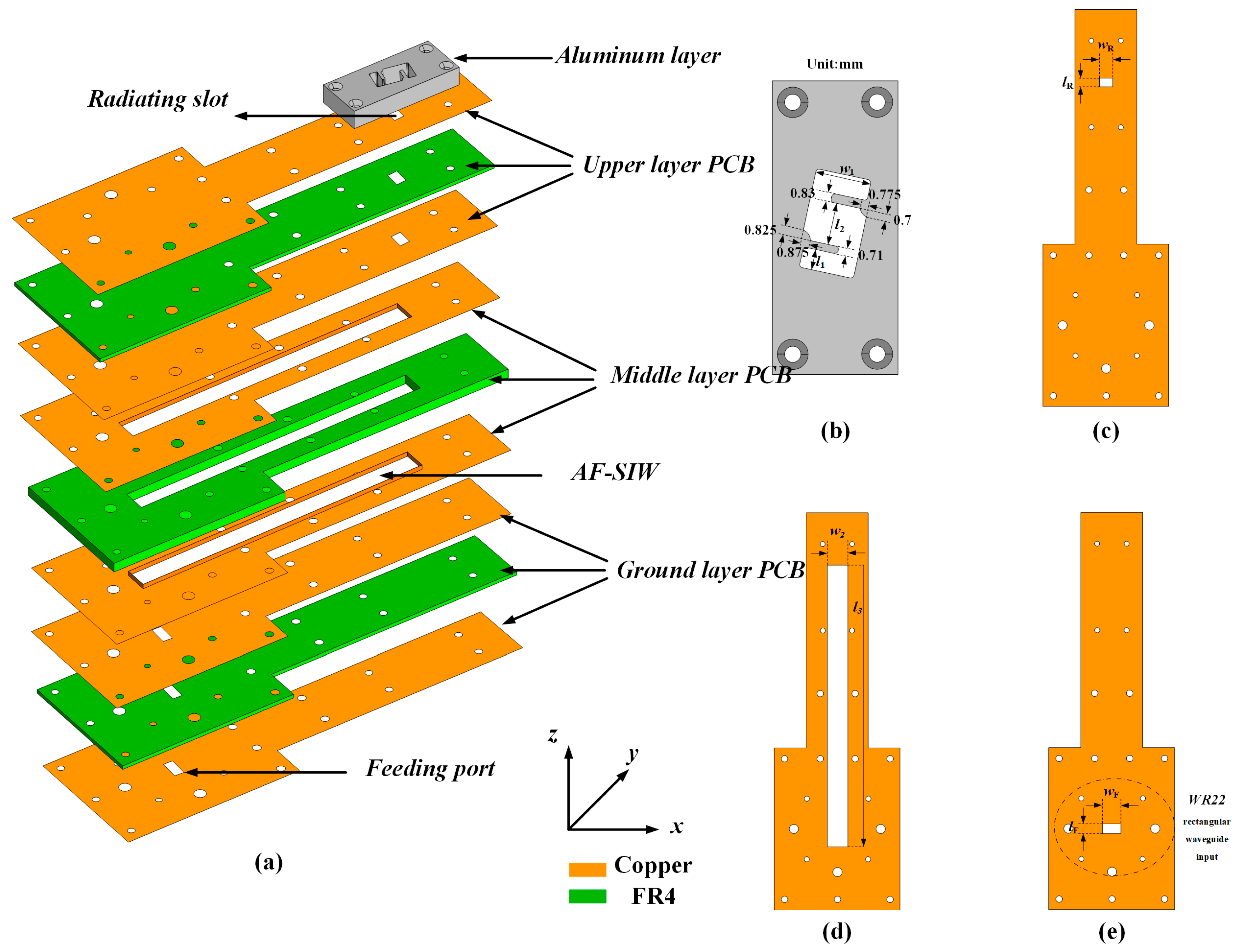
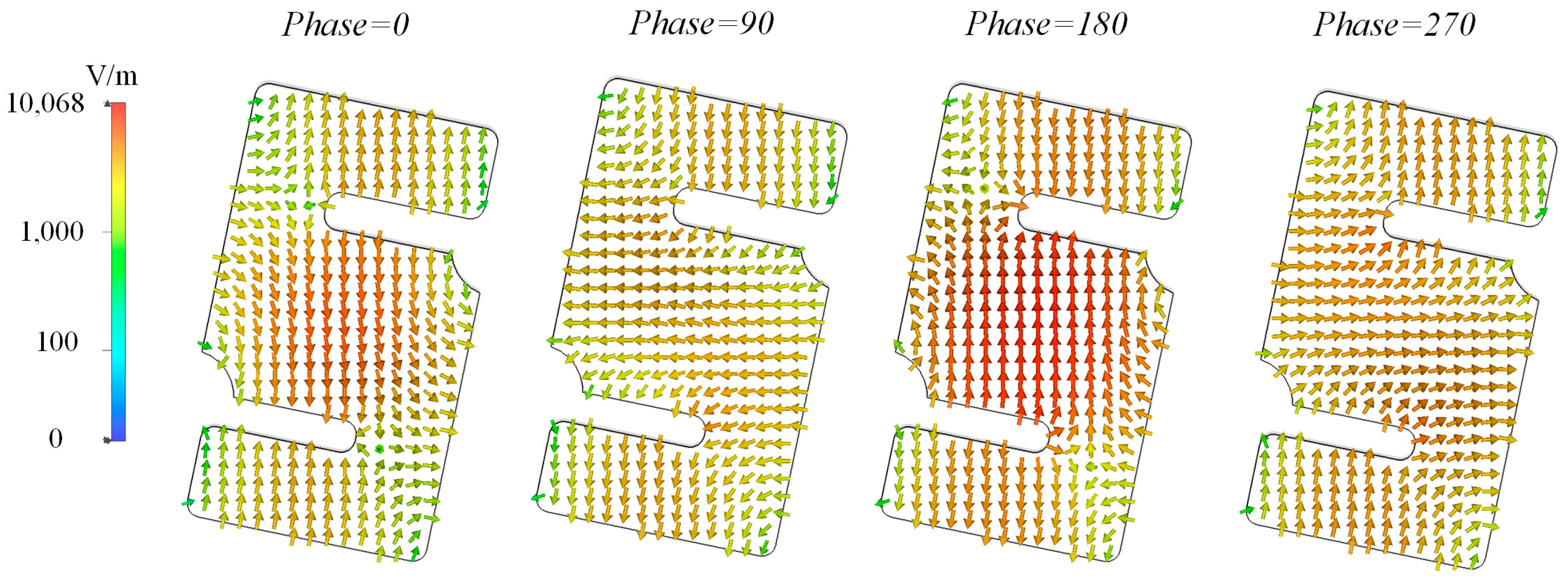
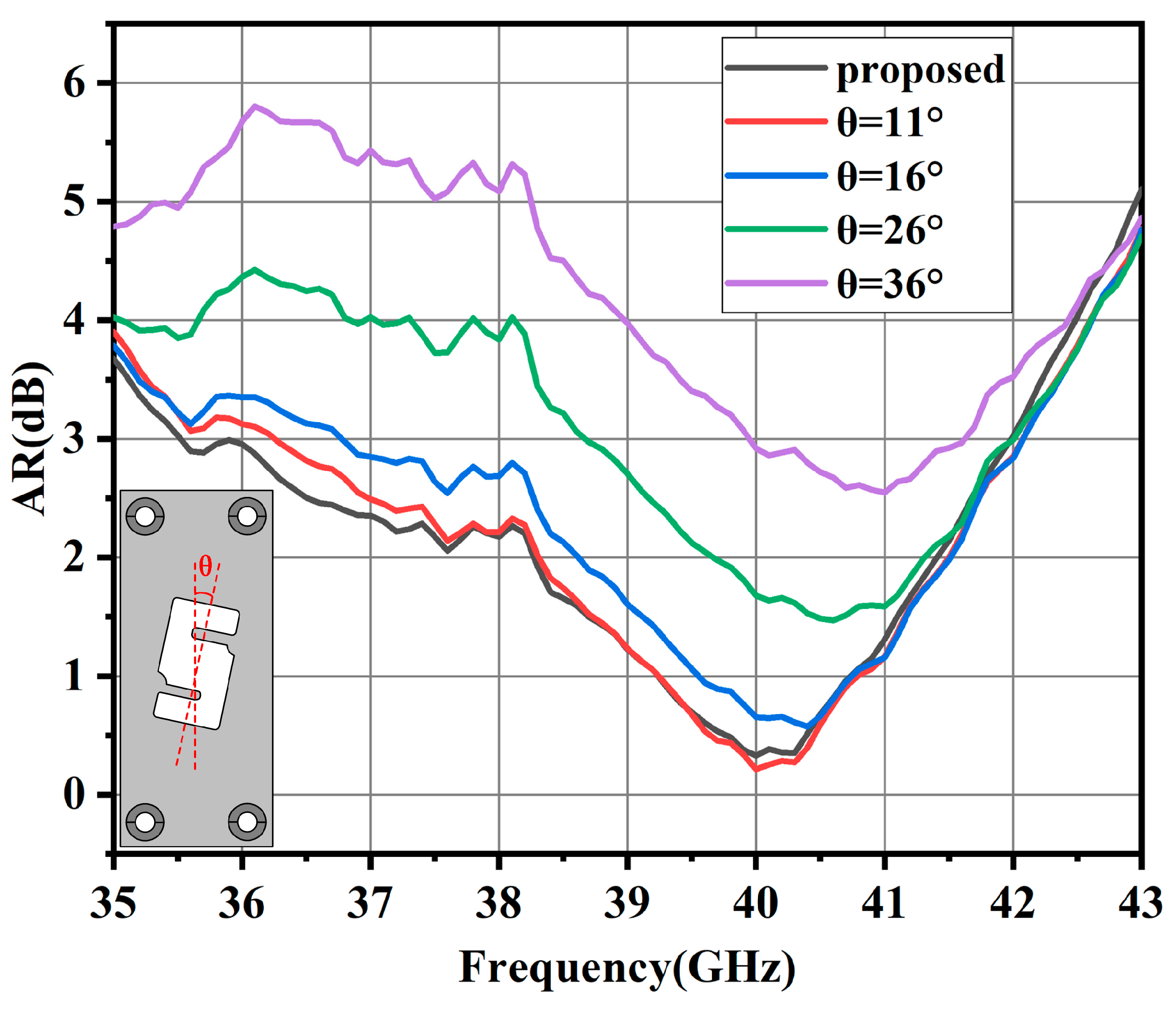
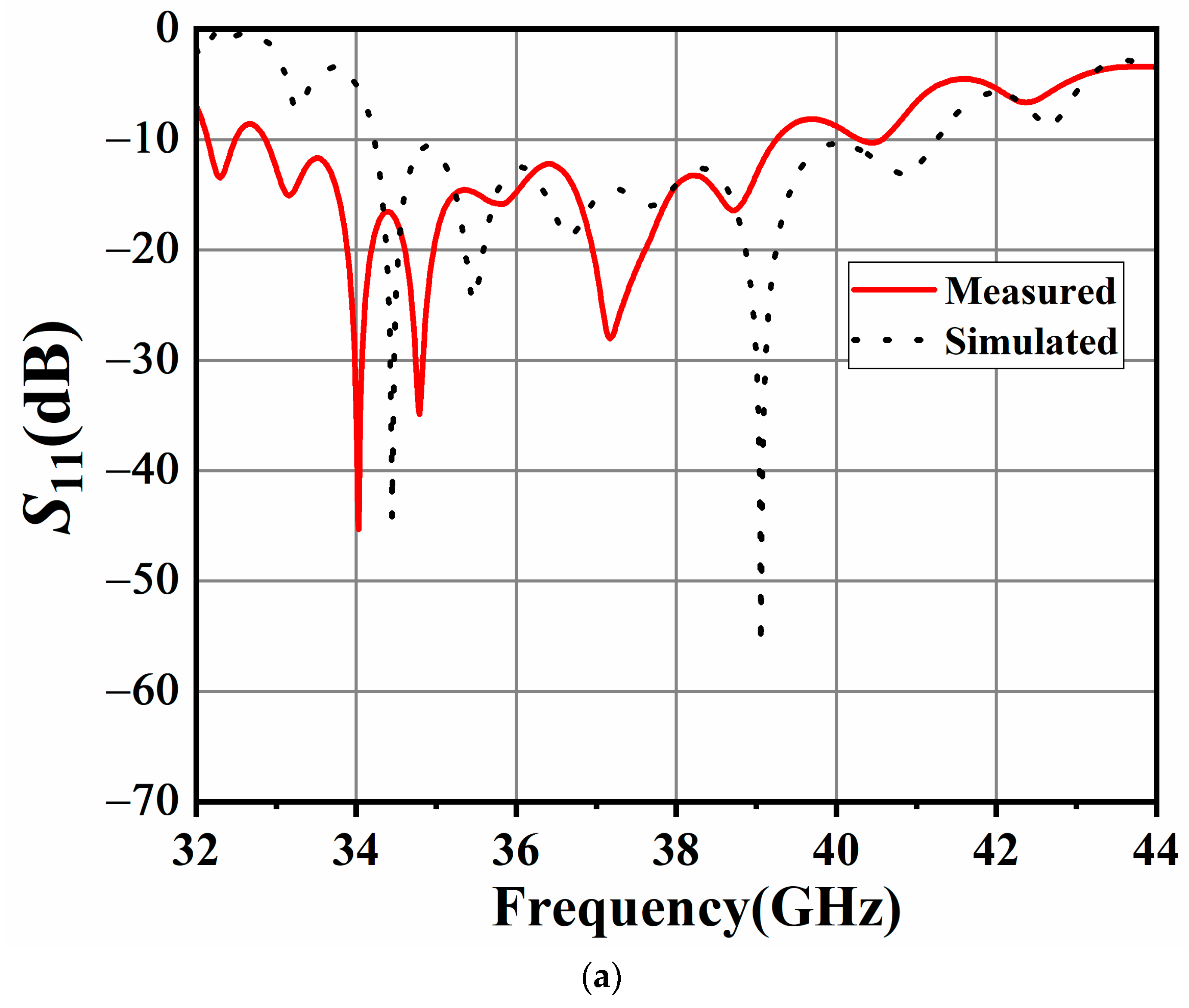



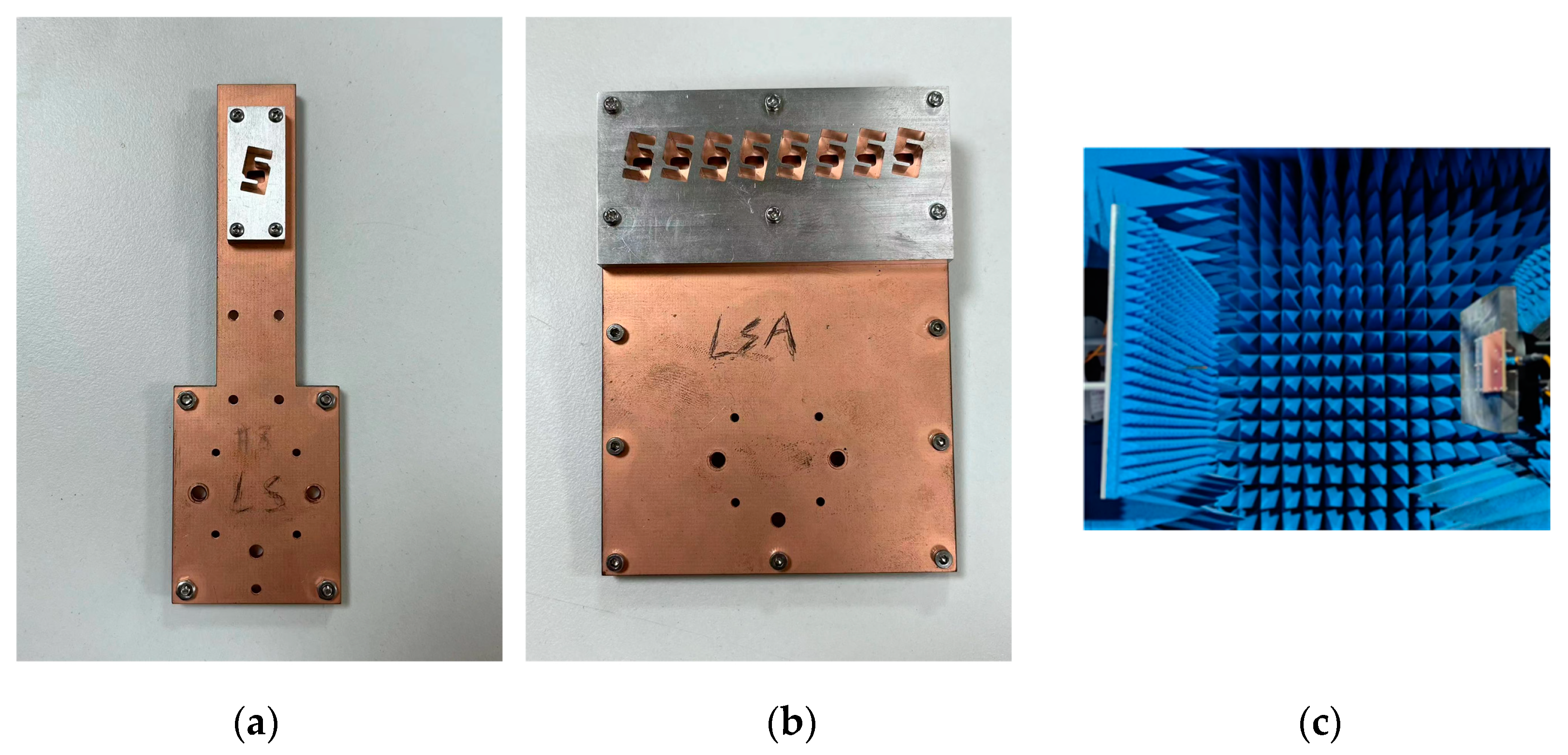
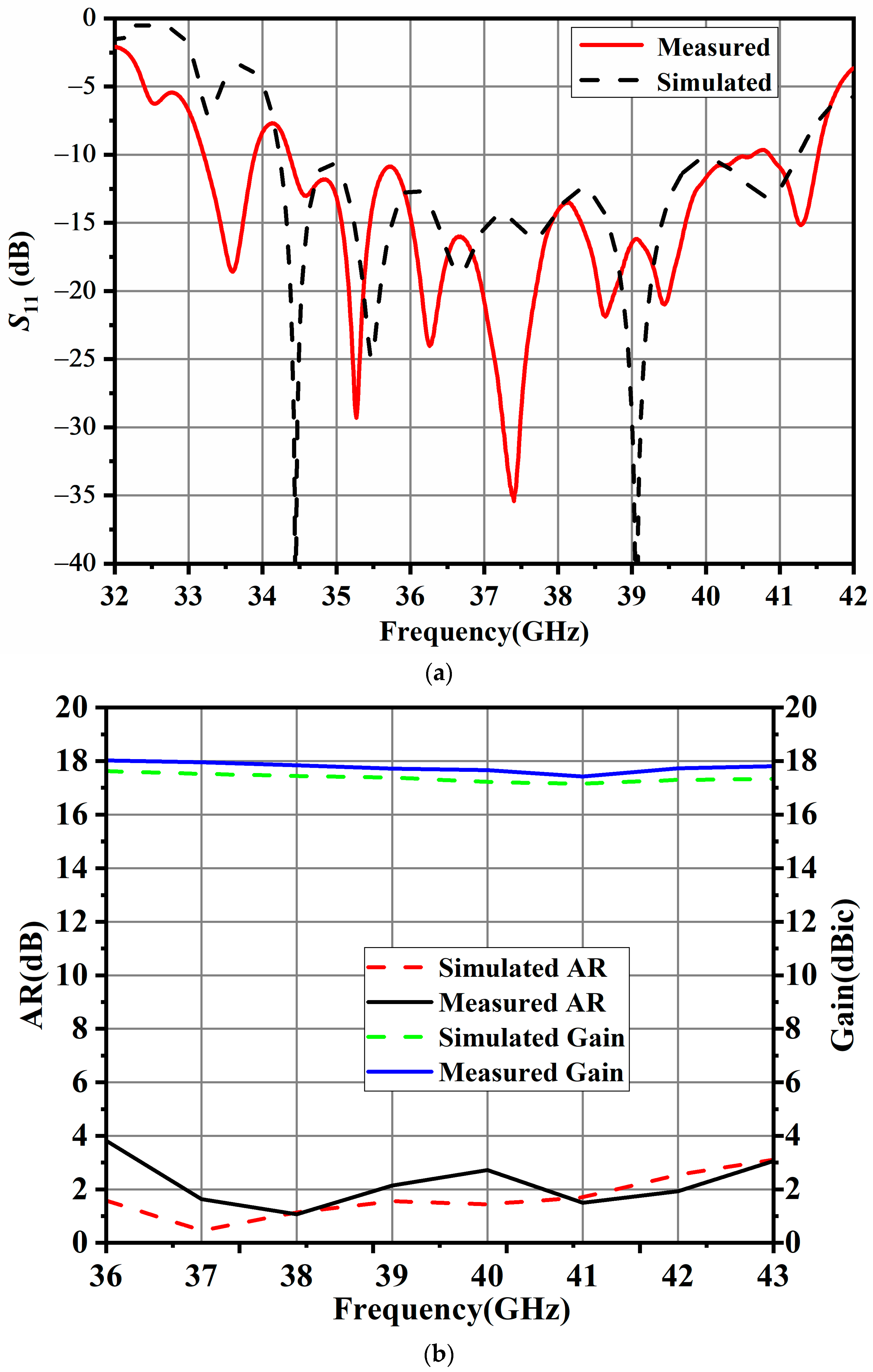

| Parameter | Value (mm) | Parameter | Value (mm) |
|---|---|---|---|
| w1 | 5 | l2 | 4 |
| w2 | 5.93 | l3 | 77.49 |
| wF | 5 | lR | 2.5 |
| wR | 3.8 | lF | 2.6 |
| l1 | 2 |
| Parameter | Value (mm) | Parameter | Value (mm) |
|---|---|---|---|
| w3 | 0.67 | l4 | 1.15 |
| w4 | 6.8 | l5 | 2 |
| w5 | 3.8 | l6 | 4.3 |
| w6 | 0.5 | l7 | 0.7 |
| w7 | 4.5 | l8 | 1.35 |
| w8 | 4 | l9 | 1 |
Disclaimer/Publisher’s Note: The statements, opinions and data contained in all publications are solely those of the individual author(s) and contributor(s) and not of MDPI and/or the editor(s). MDPI and/or the editor(s) disclaim responsibility for any injury to people or property resulting from any ideas, methods, instructions or products referred to in the content. |
© 2024 by the authors. Licensee MDPI, Basel, Switzerland. This article is an open access article distributed under the terms and conditions of the Creative Commons Attribution (CC BY) license (https://creativecommons.org/licenses/by/4.0/).
Share and Cite
He, W.; Hong, J.; Ren, Y.; Deng, Y.; Wang, X.; Fang, X. A High Gain Circularly Polarized Slot Antenna Array for 5G Millimeter-Wave Applications. Sensors 2024, 24, 6175. https://doi.org/10.3390/s24196175
He W, Hong J, Ren Y, Deng Y, Wang X, Fang X. A High Gain Circularly Polarized Slot Antenna Array for 5G Millimeter-Wave Applications. Sensors. 2024; 24(19):6175. https://doi.org/10.3390/s24196175
Chicago/Turabian StyleHe, Wei, Jun Hong, Yongmei Ren, Yuanxiang Deng, Xiaohu Wang, and Xiaoyong Fang. 2024. "A High Gain Circularly Polarized Slot Antenna Array for 5G Millimeter-Wave Applications" Sensors 24, no. 19: 6175. https://doi.org/10.3390/s24196175
APA StyleHe, W., Hong, J., Ren, Y., Deng, Y., Wang, X., & Fang, X. (2024). A High Gain Circularly Polarized Slot Antenna Array for 5G Millimeter-Wave Applications. Sensors, 24(19), 6175. https://doi.org/10.3390/s24196175






